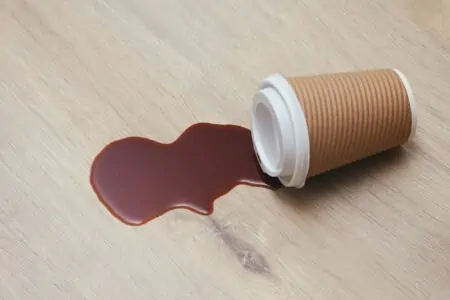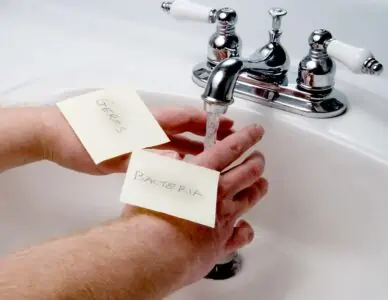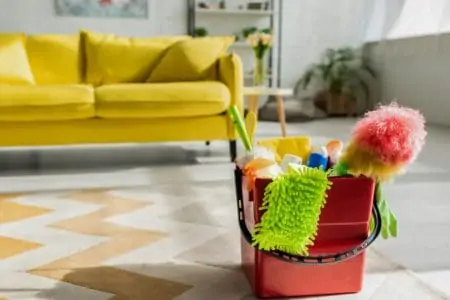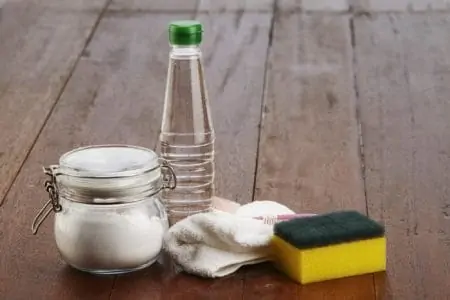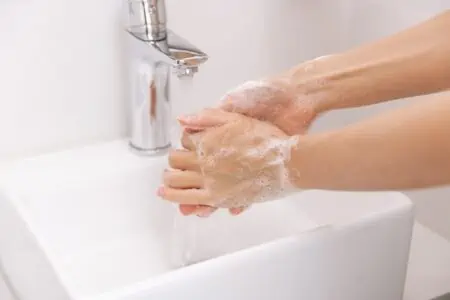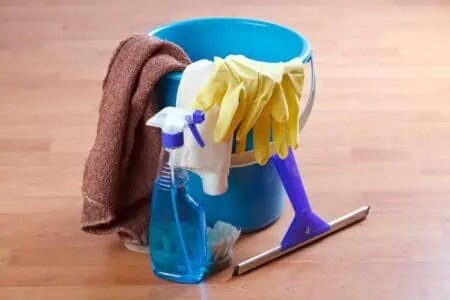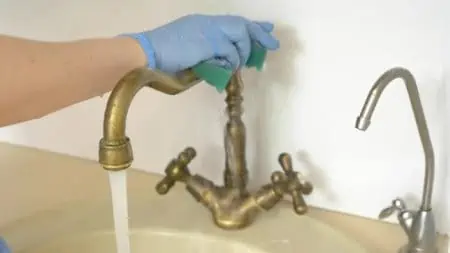There are two types of wood stains: stains from food, drinks, and other spills; and wood stain finish which is a type of paint to cover and protect the wood.
Whether you’re looking to clean away scuffs and stains on your wood pieces or remove a wood stain finish — we can help.
Bring your pieces back to life with our methods for how to remove stains from wood. We’ll walk you through how to remove old stain finishes before restaining. And we’ll show you how to remove stains from food, water, alcohol, and more.
Key Takeaways
- Remove wood stain by washing with soapy water, applying wood stain remover, waiting 30 minutes, and scraping it off with a putty knife.
- Sand the wood after 24 hours, starting with 100-grit sandpaper and moving to 180-grit to prepare for restaining.
- Use mineral spirits to remove any remaining stains before wiping the wood with a cloth.
- Removing old stains before restaining wood ensures better absorption, a more professional finish, and an even coating.
Do You Have To Remove Old Stain Before Restaining Wood?
When restaining a piece of wood to change the color, you will need to remove the old stain finish first. When you remove the old stain, the new stain will absorb into the wood better, providing a more professional and durable finish. It also ensures an even coating without bumps, pores, and flaking.
As for removing stains from spills — we also recommend working to remove them. A new wood stain finish might dull the appearance of the stain, but it won’t necessarily hide it.
How to Remove Stain From Wood
Since it’s important to remove stain before restaining, we’ll show you how. For this method, we’ll be using a wood stripper and sandpaper.
- Time: 1.5 hours (plus waiting time).
- Difficulty: Intermediate.
What You’ll Need
- Face mask.
- Safety glasses.
- Protective gloves.
- Putty knife or plastic scraper.
- Steel wool.
- Rags.
- 100-150 grit sandpaper.
- 180 grit sandpaper.
- Natural bristle paintbrush.
- Wood stain remover.
- Drop cloths.
- Metal or glass pan or bucket.
- Dish soap.
- Trash can.
- Mineral spirits (optional).
- Handheld vacuum cleaner.
1. Prepare Your Workspace
Set up your workspace in a well-ventilated area. Wear your face mask, safety glasses, and protective gloves. Since you’re working with a chemical-based wood stain remover and possibly mineral spirits, you want to be safe.
2. Wash the Wood
Make a soapy solution of water and dish soap in your metal or glass bucket. Dip a cloth into the mixture and wash the wood before drying it with a separate rag.
3. Apply Wood Stain Remover
Read the manufacturer’s instructions on your wood stain remover. Generally, it will ask you to shake it well before pouring it into the metal or glass bucket or pan.
Working in small areas of about one square foot, apply the wood stain remover using your natural bristle paint brush. Apply thick, even layers. Let the stripper set for the recommended amount of time — this is usually about 30 minutes.
Top Tip
If the piece you’re working on is big — like a large dresser or hardwood floors — work on one area at a time. It will be stressful to work in a huge area at once. It might take longer, but it will be more approachable.
4. Scrape off Stain Remover
When the stain remover starts to bubble or the recommended time is up, scrape it off with your putty knife or plastic scraper. Scraping it directly into the trash can will keep your workspace clean.
Once you’ve removed as much as possible, scrape off the excess with steel wool. Rub it in the direction of the grain.
Dampen a cloth and wipe the wood again to remove all excess material.
For Detailed Pieces
If your wood piece has carvings and fine details, use a toothbrush to get into nooks and crannies.
5. Sand the Wood
Let the wood dry for 24 hours before sanding. Start with lower grit sandpaper, around 100 to 150. Gently sand the wood to remove excess residue, but don’t work at grinding down the wood.
Once you’ve removed the excess, wipe away the residue with a rag.
Then use your higher grit 180 sandpaper to sand the wood until it’s smooth. Work in the direction of the grain.
6. Vacuum the Wood
Use a handheld vacuum cleaner to remove any excess dust.
7. Remove Stains
If you have any stains or water marks on the wood, use mineral spirits to remove them. Simply pour the mineral spirits onto a cloth and scrub the stain.
8. Wipe the Wood
Dampen a cloth with water or mineral spirits and wipe the wood in the direction of the grain. You’re now ready to restrain the piece!
Can You Remove Stain From Wood Without Sanding?
If you don’t want to sand a piece of furniture but you want to lighten the wood stain, there is something you can try. This is extremely useful if you’ve recently stained a piece but it turned out darker than expected.
Firstly, you want to let the existing stain completely dry. Then wash the piece with mild soap and water. Let it fully dry before moving on to the next step.
Use 0000 steel wool and dampen it in warm water before rubbing it along the piece in the direction of the grain. This might take a few passes before you notice the color start to lighten.
If necessary, add mineral spirits to the steel wool and repeat the above steps.
If you’d like to remove much more of the stain without sanding, then use paint and varnish stripper. Follow the directions on your chosen project.
Generally, this will involve applying the stripper to the wood with a paintbrush and waiting 30 minutes before scraping with a plastic scraper or putty knife. For some products, like Citristrip, you can wait up to 24 hours before stripping it off. The longer you wait, the more layers it will strip off at a time.
Afterward, you will need to use a paint stripper wash to remove excess residue. Then wipe the wood with mineral spirits and let it dry completely before restaining.
What to Look For in a Wood Stain Remover
When learning how to strip stain from wood, you’ll notice you need a wood stain remover. With many options on the market, how do you know which one to choose?
There are a few details to consider.
Chemicals
While most wood stain removers still contain chemicals, you might want to look for one without super harsh chemicals.
For instance, a methylene- and chloride-free formula is worth checking out. You can also find wood stain removers that contain low-volatile, non-caustic organic compounds. Either way, you want to ensure you still wear protective gear when working with the wood stain remover.
Fast-Acting
How quickly does the product work? Generally, we want to look for one that works within a few hours, so you’re not waiting forever to move on to the next step.
We also want to consider whether the stripper can work through multiple layers of stain or just one. If it can eat through multiple layers, you can get through your project much faster.
Ability To Remove
It’s important to check what the stripper can remove. Is it all kinds of wood stains, including oil or water-based? Does this include paint?
If you have multiple projects to work on, you will want to choose something more versatile. This might even include the ability to remove stripper from other materials, like metal, masonry, and more.
You should also check what the stripper works on. Is it suitable for floors, tables, cabinets, furniture, and more?
Square Footage
Check out how far the product can go. If working on floors, this is extremely important. Make sure to choose something that can cover a large area to save money.
How to Remove Stain From Wood Without Chemicals
While you can find wood stain strippers that are safe, even for indoor use, you might want to avoid chemicals altogether. We’ll share how to clean stain from wood using household items.
Sanding the Wood
One way to remove wood stain from your furniture is by harnessing the power of sandpaper alone. This might take a lot longer and be less effective, but it will essentially manually strip the piece back to its raw wood.
Clean the surface with mild soapy water before using 80-grit sandpaper over the entire surface. Move in the direction of the grain, with minimal pressure, to avoid damaging the wood.
Then move up to 150-grit sandpaper, wiping off the excess dust before moving onto 220-grit sandpaper. You will need to use some extra elbow grease to remove excess wood stain residue.
Wipe the wood, and wash it well using a rag soaked in water. Let it air dry before restaining.
Steaming the Wood
If you have a handheld steamer in the closet, give it a go. The steam can remove wood stains without any harsh chemicals or fumes.
Hold the steamer an inch away from the wood for about 15 seconds per area. Scrape the loosened paint with a putty knife or plastic scraper as you go. Then move on to the next area.
Let the wood dry before sanding it down until it’s smooth.
Flour, Water, and Washing Soda
You can make a homemade paint remover using items you might already have in the pantry. For this, mix equal parts water and washing soda to create a paste. In a separate container, combine ⅔ cup of flour and hot water until you have a gel-like consistency.
Combine both ingredients, and voila, you have an all-natural stain remover that’s safe for indoor use. You can use it in place of a wood stripper using our method above.
Baking Soda and Cornstarch
You can use this method if you have low-tannin wood and a non-toxic wood stain on the piece. It’s vital to ensure the wood is low in tannin since baking soda can react with tannins and cause new stains. For instance, maple, birch, and aspen have low tannin levels.
To use this method, boil four cups of water. Mix with ½ cup of cold water and one cup of cornstarch in a separate container to create a thick paste. Pour the boiled water into a bucket and add ¾ cup of baking soda and one tablespoon of distilled white vinegar. Stir it together before adding your cornstarch paste.
Apply the mixture onto the wood with a paintbrush and let it sit for a few minutes. Then scrub it with stripping pads or a wire brush, using some elbow grease. Once you’ve removed the wood strip, you can sand the piece using 60-grit sandpaper. Then increase to 80-grit until your wood is smooth.
Expert Advice
If you notice the sandpaper is coarse enough to scratch the wood, always move up to a higher grit.
Removing Different Stains From Wood
You know how to remove stains from wood, but what about cleaning marks and scuffs? We’ll show you the ins and outs of removing stains from wood, whether it’s from oil, water, food, or something else.
Oil-Based Stains
We’ll show you how to remove oil-based or greasy stains on your wooden pieces. Whether this is from spilling your dinner or spilling olive oil onto the floor, we can help.
- Soak up oil: Grab a paper towel and soak up as much of the oil as possible. Blot well until you’ve removed as much excess as you can.
- Create detergent: Mix warm water and mild detergent, such as dish soap, in a small bowl.
- Clean the area: Dampen a cloth in the soapy solution and apply it to the area, blotting, not rubbing. Be gentle and work in the direction of the wood grain. For deeper stains, scrub the soap in with a soft-bristled brush.
- Rinse: Dampen a separate cloth with plain water and wipe the area down to remove oily residue and soap.
- Dry: Dry the area by patting it with a rag or paper towel.
Dark or Stubborn Stains
If you have stubborn dark or black stains, you might need to try bleach, hydrogen peroxide, or oxalic acid.
- Prepare the cleaner: Place some bleach or oxalic acid into a bowl.
- Apply: Dip a brush — such as an unused toothbrush — into the solution. Scrub the stain.
- Wait: Leave it on for five minutes to two hours, depending on the severity of the stain.
- Wipe: Wipe the bleach or acid away with a damp cloth, and apply some distilled white vinegar to prevent discoloration.
If that doesn’t work, you might need to use a commercial stain remover, such as Parker & Bailey Cleaner.
Water Stains
In our experience, the most effective way to remove water stains is to sand the wood with high-grit sandpaper and then re-oil it. However, you can use mayonnaise for fresher stains that have been there for a few days or less.
- Apply mayonnaise: Put a little bit of mayonnaise onto a rag and apply it directly to the stain. Ensure that the entire stain is coated. The oil in the mayonnaise will work to remove the stain and moisturize the wood.
- Wait: Leave the mayonnaise on the stain overnight.
- Wipe: Wipe the mayonnaise away with a soft cloth.
- Apply furniture polish: If necessary, apply furniture polish or sealer to brighten the area.
Pet Stains
Hydrogen peroxide will work best to remove pet stains on wood floors. Just keep in mind that it’s not the best method for removing the odors alongside the stain.
- Pour hydrogen peroxide: Pour three percent hydrogen peroxide into a spray bottle.
- Spray: Spray the stained area and let it sit for a few minutes.
- Wipe: Wipe away the hydrogen peroxide with a microfiber cloth, rubbing quite hard for stubborn stains.
- Rinse: Rinse the area with water.
- Dry: Dry thoroughly with a cloth. Use a hairdryer on low heat to blast away excess moisture. You want to avoid leaving behind dampness, which can create a water stain.
- Repeat: Repeat the above steps if necessary.
Keep In Mind
You might need to sand and refinish the area if the hydrogen peroxide has discolored the wood. Since you’re only leaving it on for a few minutes, it shouldn’t cause discoloration. But if you forget about it and accidentally leave it on for a few hours, it can lighten the wood.
Food Stains
It’s easy to remove food stains from wood using dish soap.
- Remove excess: If you’ve spilled your dinner on your wood floor or table, remove all the excess food before cleaning.
- Make a solution: Mix warm water and a few squirts of dish soap in a bowl or spray bottle.
- Apply: Apply the soapy solution to the stain by spraying it on or using a cloth. Scrub the area well to remove the stain.
- Rinse: Use a damp cloth to rinse the area before blotting it dry.
Alcohol Stains
A relaxing evening at home can be ruined if you spill alcohol on your favorite wooden piece. But not to fear — we’re here to help you with removing stains from the wood.
- Soak up excess: Use a cloth or paper towel to soak up as much liquid as possible. Make sure you use a white cloth to avoid color transfer.
- Oil the wood: Pour a little cooking oil onto a cloth and rub the stain gently. Move in the direction of the grain. Add more oil if necessary. Continue until the stain has been removed.
- Wipe: Wipe the area with a dry cloth to remove the excess oil.
- Steel wool: If the stain remains, scrub 0000 steel wool over the area. Continue until the stain has gone.
- Wipe: Wipe away the dust with a cloth.
- Shine the wood: Apply some wood polish or wax to bring the shine back.
Tips For Wood Stain Removal
When removing old stains from wood, there are some things to keep in mind to ensure your project runs smoothly. Here are our favorite tips:
- Check the area: Before getting started, check if the wood stripper you’re using is safe for indoor or outdoor use. Make sure you work in a well-ventilated spot to avoid the fumes affecting you.
- Protect the area: Avoid spilling the products onto other surfaces. Put down a tarp or cardboard to protect your floors or table.
- Protecting the walls: If you’re removing wood stains from floors, put painter’s tape along the seams where the floor and walls meet.
- Remove stains before restaining: Once you’ve removed the wood finish, you might notice stains on the original wood. It’s important to remove those before restaining the wood, as they might be visible under the next color.
- Remove hardware from furniture: You don’t want any chemicals you use to destroy the hardware on furniture. So remove handles and hinges before getting started.
FAQs
Removing Stains
Whether you want to remove old wood stains from furniture or blast away ugly marks, we’ve got tons of tips and tricks.
Removing stain from wood is a bit of a long project but a super fun DIY experience. Tackling water, alcohol, and food stains from your wooden furniture is easy and a must-have skill.
